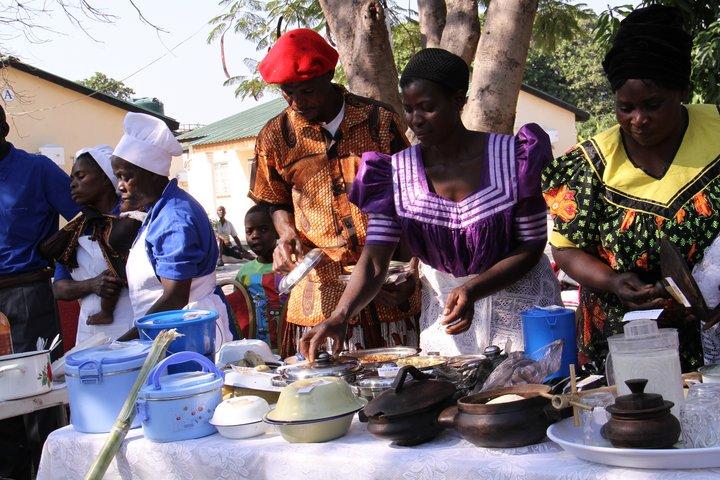From the Field Stimulating demand for nutritious diverse foods in the Barotse Floodplain, Zambia

Community members showcase diverse traditional foods with a nutritious twist at the Barotse Food Fair
How diverse are the foods of communities living on the Barotse floodplain in Zambia – a challenging environment which is flooded annually by the Zambezi river, meaning that communities need to migrate to higher land to farm for part of the year?
Which preservation methods and seasonal crops can help them through the lean months?
How can traditional recipes be made more nutritious though addition of locally available ingredients, including wild foods, that may differ throughout the year?
The food fair organized in Mongu, Zambia, last month helped to answer some of these questions – Bioversity International's Verena Nowak and Ewa Hermanowicz report, in collaboration with Mate Chuma from Worldfish.
At the Barotse food fair, ten communities prepared a colourful parade of tasty dishes showcasing the rich diversity of their seasonal foods, and sharing their knowledge and skills in preparing traditional recipes while adding a nutritious twist – thanks to a participatory research initiative led by Bioversity International and WorldFish to bring local nutritious diversity to the Barotse menu.
Preparation of dishes in the region is usually very simple. For example, they often boil green leafy vegetables without adding any other ingredients. However, using knowledge about combining different foods for improved nutrition gained through the research programme, the women showed how adding additional ingredients such as pounded groundnuts and dried fish to cassava leaves, or adding pumpkin leaves and groundnuts to pumpkin dishes, could enhance nutrition.
Some communities also brought wild fruits to the show as part of the dishes on exhibition, such as namulomo (unidentified species), linjefu (water nut), mashela (water lily), and the already mentioned muzauli (African Rosewood Seed) which contain significant amounts of essential nutrients, vitamins and minerals.
Some women at the food fair shared their perceptions of what they had learnt through the programme:
Nalishebo explained that she had never known how to cook for babies, but since she joined the cooking group, she has learnt how to prepare nutritious porridge by adding dried pounded vegetables to maize meal.
Beatrice described how she is now adapting local recipes using diverse ingredients, “We only knew about pounding cassava leaves, then adding muzauli. After the cooking demonstrations we learnt new ways to cook these same ingredients. For example, we came up with a recipe to make scones which we then fry. The children love them.”
This first Barotse food fair was a really successful event, bringing together different research partners, Ministries and community members, to share knowledge, stimulate demand and advocate for research and development activities that use local diverse nutritious food across the seasons.
At the end of the fair, a judging committee, including representatives from the Ministry of Agriculture, the National Food and Nutrition Commission, and Worldfish, declared two winners. But most importantly, everyone attending got the chance to taste and learn about these delicious and nutritious diverse foods from the most remote villages of the floodplain.
See photos from the fair on Flickr
For more information, please contact:
Verena Nowak or Ewa Hermanowicz
This work on nutrition-sensitive landscapes is carried out by Bioversity International in partnership with the Farming Systems Ecology (FSE) group from Wageningen University and the Earth Institute at Columbia University, to characterize the Barotse landscape and its current farming systems. It is part of the CGIAR Research Program on Aquatic Agricultural Systems (AAS) and the CGIAR Research Program on Agriculture for Nutrition and Health (A4NH).
Special guests at the event included three Indunas, who are the local leaders and eminently respected members of the communities, and Dr. Kate Longley, Team Leader of the CGIAR Research Programme on Aquatic Agricultural Systems in Zambia. Support also came from Harvest Plus who prepared meals from orange maize and talked about the importance of vitamin A in the diet.
